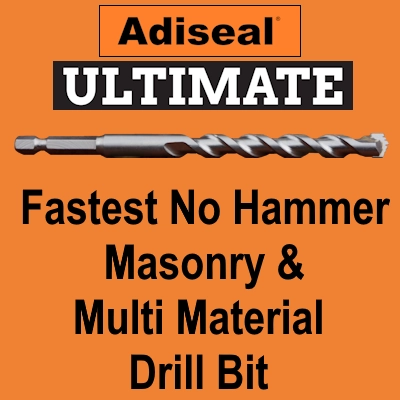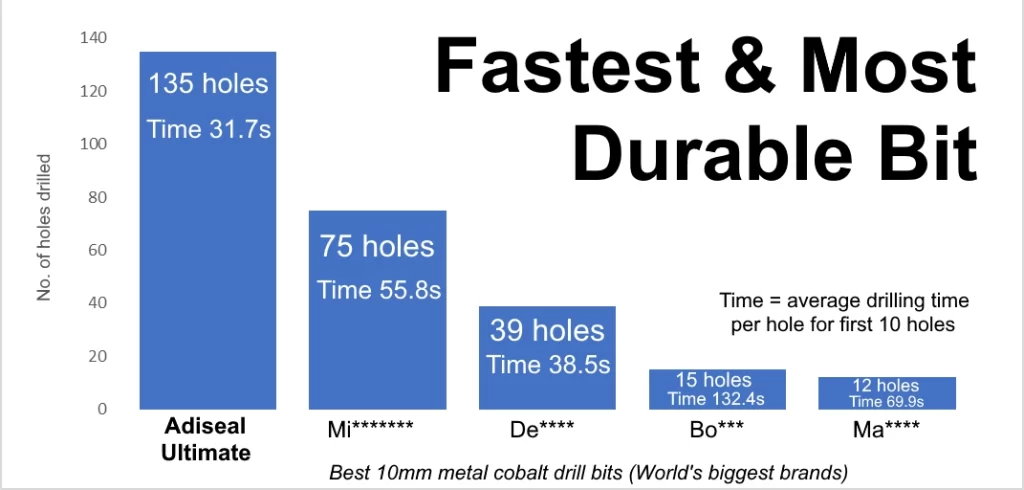Concrete Drill Bit
What is the Best Drill Bit for Concrete, Brick, Stone, Masonry
Adiseal Ultimate concrete drill bit is a masonry drill bit that outperforms other drill bits in terms of drilling speed and durability when drilling without a hammer function. It drills a variety of construction materials including concrete, brick, masonry, wood and other materials. There are numerous advantages of drilling hard materials without hammer function which we are going to go into more detail below.
- What are the advantages to no-hammer concrete drilling?
- Speed test drilling into concrete brick compared to SDS drill bit
- How to drill into concrete
- What other materials can they drill into?

What are the advantages to no-hammer concrete drilling?
Using a concrete masonry drill bit to drill concrete without hammer function instead of hammer drilling has a number of advantages including:
- Quieter drilling
- Less vibration damage on hands
- Can drill closer to an edge
- Less risk of loosening mortar
- Less risk of damaging substrate
- Drills more accurate holes in concrete
The 1/4 inch hex shank also prevents the carbide masonry drill bit from spinning in the chuck and allows quicker changes.
Quieter drilling
Using the hammer function while drilling hard materials like brick can produce loud noise, posing a risk to hearing damage and causing disruptions to others. Choosing no-hammer drilling instead, results in quieter noise, reducing the risk of hearing damage and disturbing others.
Less vibration damage to hands
Regular use of vibrating tools can lead to hand damage, including conditions like vibration white finger syndrome. Drilling without the hammer function decreases hand vibration, thereby lowering the risk of developing vibration white finger syndrome.
Can drill closer to an edge
When using a hammer drill, drilling near an edge can easily result in substrate breakage, particularly in hard materials such as concrete and brick. When drilling near the edge of a hard material, using no-hammer drilling, minimises the risk of break the substrate.
Less risk of loosening mortar
Using a hammer drill when drilling materials like concrete or brick can potentially dislodge the brick and mortar. Non-hammer drilling reduces the likelihood of this happening.
Less risk of damaging substrate
When hammer drilling on tough materials like concrete or brick, the substrate is at risk of breaking due to the impact of the bit. This is a concern, particularly in situations where the brick has been chased out, for example, to accommodate an electrical back box. A common problem when attempting to drill all the way through a brick or wall is for the hammer drill bit to break a big chunk out of the substrate when the drill bit it close to going all the way through the substrate. Drilling without the hammer function reduces the risk of substrate breakage, ensuring a safer drilling process.

Drills more accurate holes in concrete
Drilling into concrete with hammer function can result in less accurate holes. This is because the hammer function can break small bits of concrete resulting in a bigger hole then intended. To drill more accurate holes in concrete, drill without using the hammer function.
Speed test drilling into concrete brick compared to SDS drill bit
To find out what is the best drill bit for concrete and brick, we carried out a test drilling into a concrete brick. Adiseal Ultimate masonry drill bit & multi-material drill bit in a standard cordless drill without the hammer function managed to achieve the same drill time as a corded SDS hammer drill with the hammer function on. Both took 5 seconds to drill into the brick. However as can be seen in the above image, the SDS hammer drill caused the brick to break, a common issue with hammer drills. In contrast, the Adiseal Ultimate masonry & multi-material drill bit, used without the hammer function, did not cause the brick to break.
How to drill into concrete
How to drill into concrete
- Mark Your Drilling Location
Use a pencil or marker to carefully mark the exact spot where you intend to drill your hole. This will ensure drilling precision.
- Apply Steady Pressure
Align the drill bit tip precisely with the marked spot on your material. Apply consistent and even pressure as you begin drilling, ensuring the drill remains level and perpendicular to the material’s surface.
- Start Drilling
Initiate the drilling process at a slow and controlled pace. As you make your way through the material, you can gradually accelerate for faster progress. Stay attentive to the drill’s feedback, and adjust the pressure as necessary to ensure you maintain control.
- Clear Debris
Intermittently retract the drill bit to clear any gathered debris. This action prevents overheating and ensures a clean hole.
- Complete the Drilling
Keep drilling until you’ve achieved the intended depth. Exercise patience and refrain from exerting excessive force on the drill, particularly when working with tougher materials like masonry.
- Withdraw the Drill Bit
Once the drilling is finished, switch off the drill and cautiously remove the drill bit from the hole.
- Inspect and Clean
Inspect the hole to verify it meets your specifications. If needed, remove any remaining debris or sharp edges for a finished result.
What other materials can they drill into?
Adiseal Ultimate masonry drill bit for concrete & multi-material drill bit can drill into many different materials including:
- Brick
- Concrete
- Tile
- Ceramic
- Marble
- Wood
- Plastic
- Fiberglass
- Slate
- Plus other materials
Sizes available
Adiseal Ultimate hex shank masonry drill bit (multi-material) is currently available in the following sizes:
- 4mm x 100mm
- 5mm x 100mm
- 5.5mm x 150mm
- 6mm x 150mm
- 6.5mm x 150mm
- 8mm x 150mm
- 10mm x 150mm
- 12mm x 150mm
- 12mm x 400mm (Extra long masonry drill bit)
Best metal drill bit
In their attempt to make available the best drill bits, also in the Adiseal Ultimate range is the fastest and most durable metal drill bit. In out test drilling into stainless steel with a drill press, it drilled faster and drilled more holes than any other metal drill bit. It was easily the best metal drill bit and it beat the best metal drill bits from the worlds biggest brands including Milwaukee, DeWalt, Bosch & Makita.

| 10mm metal cobalt drill bit | Total number of holes drilled (in 6mm stainless steel) | Time to drill each holes (average of 1st 10 hole) |
| Adiseal Ultimate cobalt | 135 holes | 31.7 seconds |
| Milwaukee cobalt red | 75 holes | 55.8 seconds |
| DeWalt Extreme cobalt | 39 holes | 38.5 seconds |
| Bosch cobalt | 15 holes | 132.4 seconds |
| Makita cobalt | 12 holes | 69.9 seconds |
Where to buy a drill bit for concrete
To buy concrete drill bits in the UK, please contact us for details of you local stockist. For other countries that do not have a Adiseal distributor, please visit www.guglue.com
Frequently asked questions about drill bit for concrete
Adiseal Ultimate masonry drill bit has proven to be the quickest option for concrete drilling without a hammer function. It offers numerous benefits over hammer drilling, such as reduced noise, less risk of vibration-related damage, and lower substrate damage risk.
A regular drill, while capable of drilling into concrete without the hammer function, is typically slower than using a hammer drill. The Adiseal Ultimate masonry drill bit significantly accelerates the drilling process and has demonstrated equivalent speed to an SDS drill bit in tests for drilling into concrete brick without the hammer function.
Drilling into concrete with a cordless drill is feasible, though it usually takes more time without the hammer function. However, when using the Adiseal Ultimate masonry drill bit, it becomes the fastest option for no-hammer drilling in concrete.
Using a hammer drill increases the likelihood of concrete cracking. To minimize the risk of concrete damage, it’s advisable to drill without the hammer function, even though it may take longer. The Adiseal Ultimate masonry drill bit is the swiftest option for non-hammer drilling and has been tested to achieve drilling speeds equivalent to an SDS drill bit.
A masonry drill bit is designed to drill into hard building materials like concrete and brick.
Adiseal Ultimate masonry drill bit has been shown to be the fastest drill bit for concrete when drilling without a hammer function. It has a number of benefits over hammer drilling including lower noise, less risk of vibration-related damage, and lower substrate damage risk.
